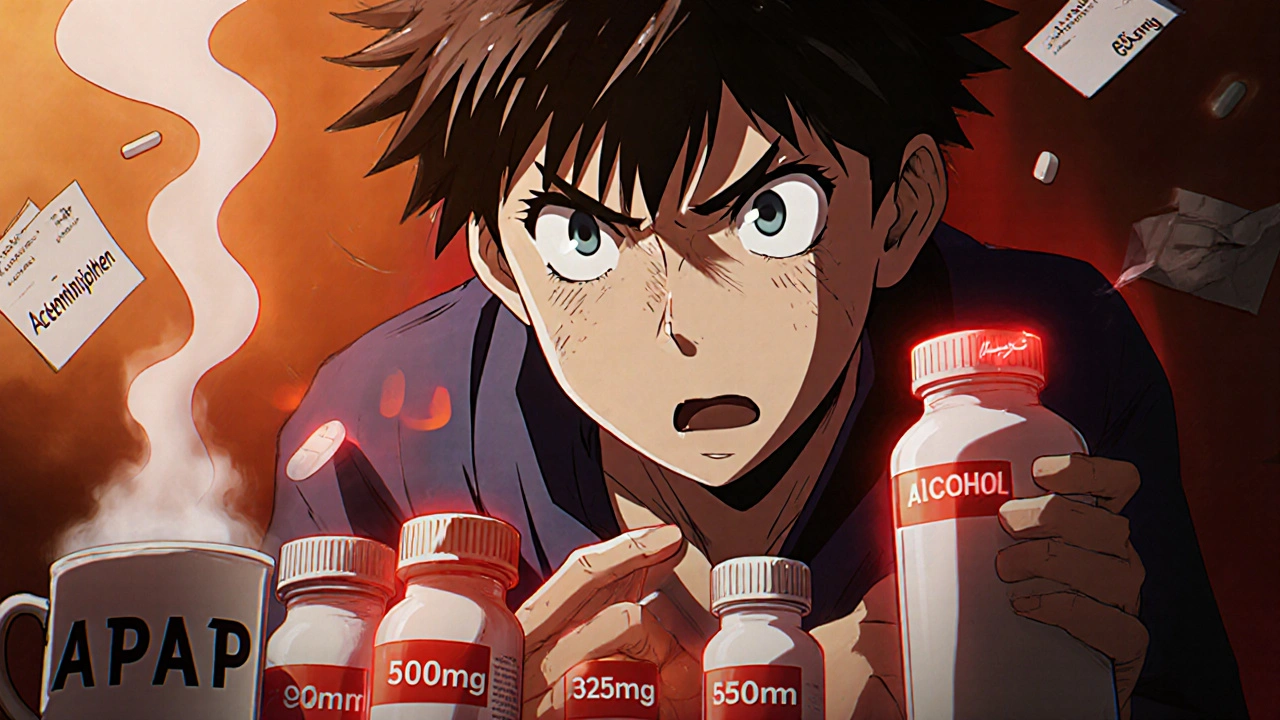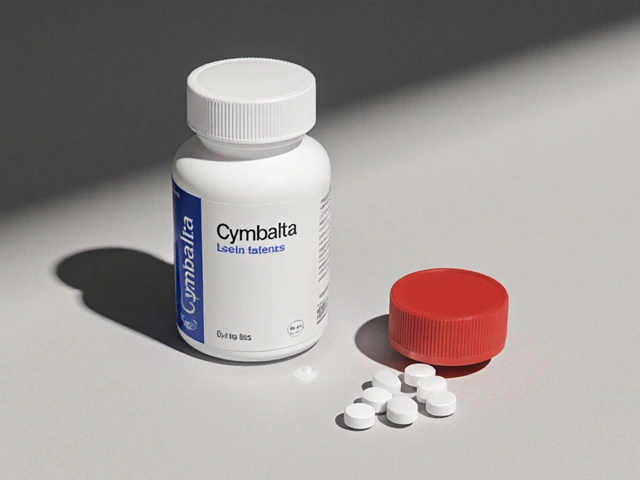
Acetaminophen is in almost every medicine cabinet. You probably know it as Tylenol. But you might not realize how easily it can turn from a safe pain reliever into a silent threat to your liver. Every year in the U.S. alone, more than 56,000 people end up in the emergency room because of acetaminophen overdose. Most of them didn’t mean to take too much. They just didn’t know how dangerous it could be.
Why Acetaminophen Is More Dangerous Than You Think
Acetaminophen works great for headaches, fevers, and muscle aches. It doesn’t upset your stomach like ibuprofen or aspirin. That’s why doctors recommend it for people with kidney problems, high blood pressure, or ulcers. But here’s the catch: the line between a safe dose and a toxic one is razor-thin.
The maximum daily dose for adults is 4,000 milligrams. That’s eight 500mg tablets. Sounds simple, right? But here’s where things go wrong. Acetaminophen is hidden in over 600 different medications-cold and flu remedies, sleep aids, prescription painkillers like Vicodin and Percocet. You might take one for your headache, another for your stuffy nose, and a third for trouble sleeping. All three contain acetaminophen. You don’t realize you’ve hit 6,000 mg by noon.
That’s not just a mistake-it’s a medical emergency. When your liver gets overwhelmed, it starts producing a deadly byproduct called NAPQI. Normally, your body neutralizes it with glutathione. But when you overdose, glutathione runs out. NAPQI starts destroying liver cells. Within hours, your liver enzymes spike. Days later, you could be facing liver failure.
The Four Stages of Acetaminophen Toxicity
There’s no sudden collapse. No screaming pain. The signs creep in slowly, which is why so many people wait too long to get help.
- Stage 1 (0-24 hours): You might feel nauseous, sweaty, or just generally off. You think it’s a stomach bug. Lab tests? Still normal.
- Stage 2 (24-72 hours): Your right upper abdomen starts to ache. Your skin turns yellow. Blood tests show your liver enzymes are climbing-sometimes over 10,000 IU/L (normal is under 40). This is when most people finally go to the ER.
- Stage 3 (72-96 hours): This is the crisis point. Jaundice, confusion, bleeding, kidney failure. Half of patients with severe overdose develop acute kidney failure. At this stage, liver transplant may be the only option.
- Stage 4 (after 5 days): Either you recover fully-or you don’t survive.
Here’s the scary part: if you take 7.5 grams in one go-just 15 extra-strength Tylenol tablets-you’re already in the danger zone. And if you’ve been drinking alcohol regularly? Your threshold drops to just 2,000 mg per day. Three beers a night can turn a safe dose into a lethal one.
Who’s Most at Risk?
It’s not just people who take pills by the handful. The biggest danger comes from unintentional overdose.
- Adults 30-50: They’re the most likely to stack cold medicine, painkillers, and sleep aids without realizing the acetaminophen adds up.
- People with liver disease: Even if they’ve taken acetaminophen safely before, their liver can’t handle even normal doses anymore.
- Older adults: They often take multiple prescriptions and OTC meds. One pill here, another there-no one checks the labels.
- Parents giving kids medicine: Using kitchen spoons instead of dosing cups leads to 12% of pediatric overdoses. A teaspoon is 5 mL. A tablespoon is 15 mL. That’s three times too much.
And here’s a shocking stat: 23% of adults don’t know acetaminophen is the active ingredient in Tylenol. They see “acetaminophen” on the label and think it’s something else. Or they see “APAP” and assume it’s a different drug.

How to Prevent an Overdose-Step by Step
You don’t need to avoid acetaminophen. You just need to use it wisely.
- Know your limit: Never exceed 3,000-4,000 mg per day. For safety, aim for 3,000 mg if you’re over 65, have liver issues, or drink alcohol.
- Read every label: Look for “acetaminophen” or “APAP.” Check every cold medicine, allergy pill, sleep aid, and prescription painkiller. If it has either, it counts toward your daily total.
- Never mix with alcohol: Even one drink a day increases your risk. Two or three? You’re playing Russian roulette with your liver.
- Use the right measuring tool: For liquids, always use the dosing cup or syringe that comes with the bottle. Never use a kitchen spoon.
- For kids, use weight-based dosing: Give 10-15 mg per kilogram of body weight every 4-6 hours. Max 5 doses in 24 hours. Never give adult pills to children.
- Write it down: If you’re taking multiple meds, keep a log. Note the name, dose, and time. It helps you track total acetaminophen intake.
What to Do If You Think You’ve Taken Too Much
Don’t wait for symptoms. Don’t hope it’ll pass. If you suspect an overdose-no matter how small-call Poison Control immediately: 1-800-222-1222 (U.S.) or your local poison center.
The antidote, N-acetylcysteine (NAC), works best if given within 8 hours. After 16 hours, its effectiveness drops by half. If you get NAC early, your chances of full recovery are over 90%. Wait too long? You could end up on a transplant list-or worse.
Emergency rooms can run a blood test to measure acetaminophen levels. They’ll use the Rumack-Matthew nomogram to decide if you need NAC. Even if you feel fine, if your levels are high, you need treatment.

What’s Being Done to Fix This?
Regulators are trying. Since 2011, the FDA has required all prescription combo pills to contain no more than 325 mg of acetaminophen per tablet. All OTC products now have a “Liver Warning” on the label.
But it’s not working well. Only 38% of people actually understand what that warning means. In 2023, the FDA proposed requiring “acetaminophen” to appear in bold, larger font on all packaging. They’re also exploring apps that scan barcodes and warn you if you’re about to exceed your daily limit.
Meanwhile, researchers are testing new antidotes like fomepizole, which could help when NAC isn’t an option. But none of this matters if people don’t know how to use the drug safely.
Final Thought: It’s Not About Fear-It’s About Awareness
Acetaminophen isn’t evil. It’s one of the most useful pain relievers ever made. But it’s not harmless. It’s like a chainsaw: great when you know how to use it, deadly when you don’t.
Check your medicine cabinet today. Look at every bottle. Add up the acetaminophen. Ask yourself: Could I accidentally take too much? If the answer is yes, you’re not alone. But now you know how to fix it.
Can you overdose on acetaminophen by taking too many cold medicines?
Yes, absolutely. Many cold, flu, and allergy medicines contain acetaminophen. Taking one for your fever and another for your cough means you’re doubling up. You might not feel sick right away, but your liver is absorbing the extra dose. Always check the Drug Facts label for “acetaminophen” or “APAP.”
Is it safe to take acetaminophen every day for chronic pain?
It can be, but only under medical supervision. For chronic pain, doctors often recommend staying under 3,000 mg per day. If you’re using it daily for months, your liver needs monitoring. Never take it long-term without checking with your doctor, especially if you drink alcohol or have any liver condition.
Does taking acetaminophen with food reduce the risk of liver damage?
No. Eating before or with acetaminophen doesn’t protect your liver. It might slow absorption slightly, but it doesn’t prevent the toxic metabolite from forming. The only way to reduce risk is to stay within the daily dose limit and avoid alcohol.
What’s the difference between extra-strength and regular acetaminophen?
Regular strength is 325 mg per tablet. Extra-strength is 500 mg. That means you can take fewer pills-but you also hit the daily limit faster. Four extra-strength tablets = 2,000 mg. You can only take four more over the next 24 hours. Many people don’t realize this and end up taking 8-10 pills, thinking they’re being careful.
Can you recover fully from an acetaminophen overdose?
Yes-if you get treatment quickly. If you receive N-acetylcysteine within 8 hours of overdose, your chances of full recovery are over 90%. Even if your liver enzymes are high, your liver can regenerate. But if treatment is delayed beyond 16 hours, the risk of permanent damage or death increases dramatically.
Are there safer alternatives to acetaminophen for pain relief?
Ibuprofen and naproxen are good alternatives for inflammation-related pain like arthritis or sprains. But they carry risks of stomach bleeding and kidney damage, especially in older adults. For people with liver disease, acetaminophen is still preferred-just at lower doses. The best choice depends on your health history. Talk to your doctor or pharmacist before switching.
Is acetaminophen safe during pregnancy?
Yes, when used at recommended doses. Acetaminophen is the preferred pain reliever during pregnancy because it doesn’t affect fetal development like NSAIDs can. But don’t take it long-term or in high doses. Stick to the lowest effective dose for the shortest time. Always check with your OB-GYN first.
Next Steps: Check Your Medications Today
Grab every bottle in your medicine cabinet. Lay them out. Look for “acetaminophen” or “APAP.” Add them up. If the total is close to 4,000 mg, you’re at risk. Write down what you’re taking and when. If you’re unsure, ask your pharmacist. They can scan your prescriptions and flag any overlaps.
Don’t wait until you’re in the ER. This isn’t about being scared. It’s about being smart. Acetaminophen saves lives. But only if you know how to use it right.
Write a comment
Your email address will not be published.





10 Comments
Bro. I took 3 Tylenol for my headache and a cold med with APAP for my sinuses. Felt fine. Woke up vomiting at 3 AM. Now I know why the label says 'Liver Warning' like it's a horror movie. 🤢
This is such an important post. I used to mix NyQuil and Advil PM without thinking - now I keep a little notebook. Seriously, if you take meds regularly, write it down. Your liver will thank you. ❤️
We treat painkillers like candy. But the liver doesn't have a mute button.
I read the label. I swear I did. But 'APAP'? I thought it was some fancy pharmaceutical abbreviation for 'magic healing dust'. 😅
The real issue isn't the drug - it's the systemic failure of pharmaceutical labeling, public health literacy, and the normalization of polypharmacy. We've created a culture where people are expected to be pharmacologists just to take a headache pill. The FDA's 'bold font' proposal is a band-aid on a hemorrhage. We need mandatory digital integration: barcode scanning in pharmacy apps, automated dose-tracking via EHRs, and public education campaigns that don't sound like a PSA from 1992. The fact that 23% of adults don't know acetaminophen = Tylenol isn't ignorance - it's design failure.
I had no idea cold meds had acetaminophen. I thought I was being smart by not taking extra Tylenol. Turns out I was just taking it 5 different ways. 🤦♂️ Thanks for the wake-up call.
There's a quiet horror in how casually we poison ourselves. We live in a world where the most common painkiller is also the most silent killer, and we don't even know it. We treat our bodies like machines you can just reboot with a pill. But the liver? It doesn't reboot. It just... stops. And then you're on a transplant list wondering why you didn't read the tiny print. We're not just overdosing on medication - we're overdosing on apathy.
I took 8 Tylenol because I had a migraine and my boyfriend said 'just take more, it's fine.' I ended up in the ER. The nurse asked if I knew what APAP was. I said 'is that like a new brand of gummy bears?' They didn't laugh. I still have nightmares about that day. Don't be me.
This whole thing is a Big Pharma scam. They know acetaminophen kills people quietly so they can sell NAC as a miracle cure. And the FDA? They're in on it. Why do you think they made it so hard to find the real dose info? They want you to get liver failure so you'll buy their 'safe' alternatives - which are just more expensive chemicals with different names. I checked my meds. I found APAP in my dog's flea pill. Coincidence? I think not.
It is not the responsibility of the consumer to be a pharmacologist. If a medication contains a potentially lethal substance, the manufacturer must make that information unambiguous, universally legible, and impossible to overlook. The current labeling standard is negligent. The fact that this post even needs to exist is a societal failure.